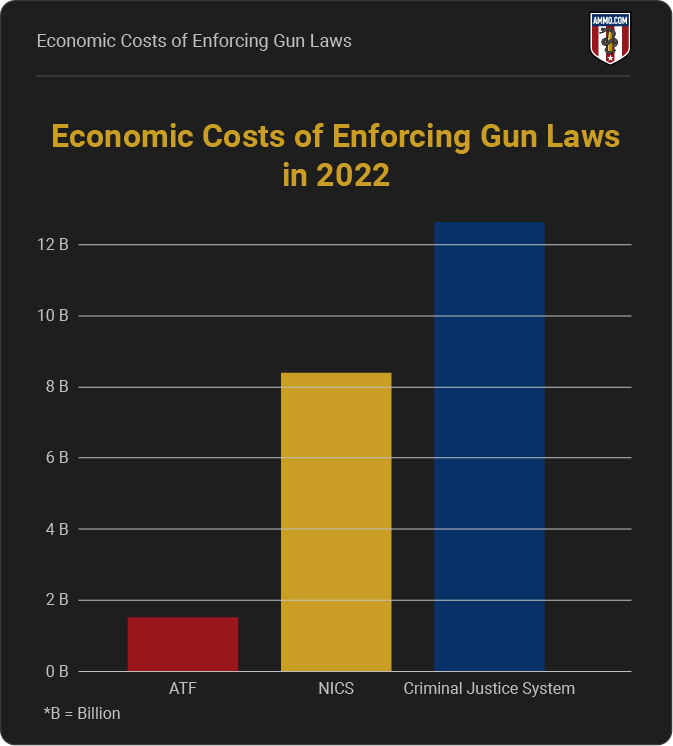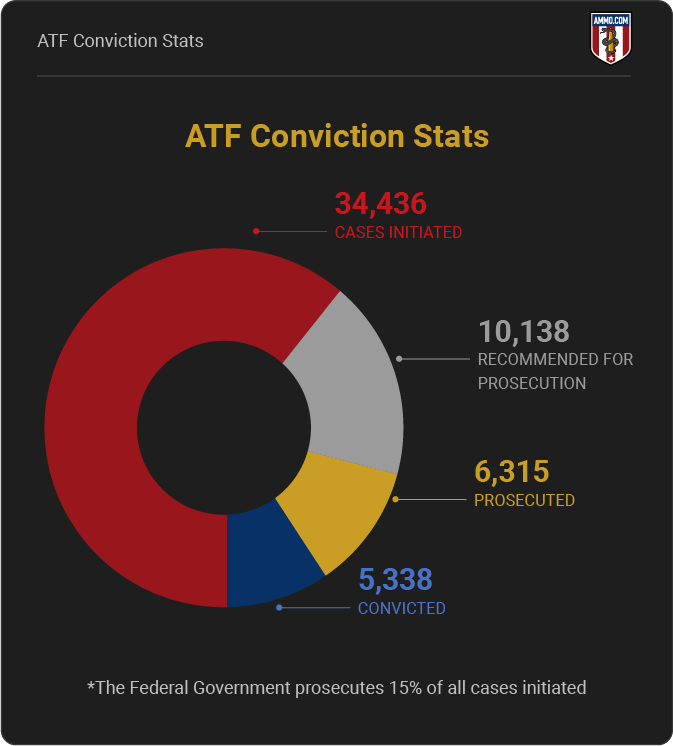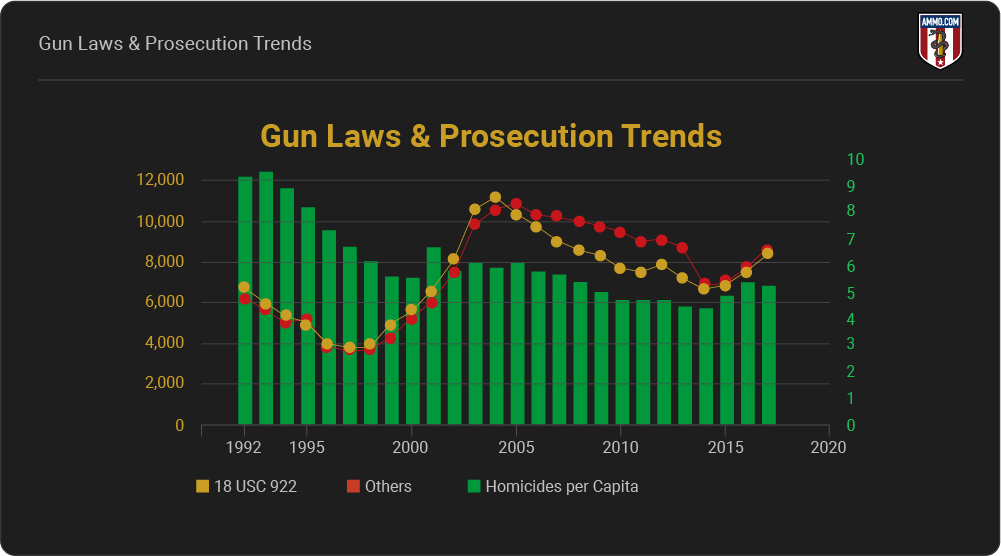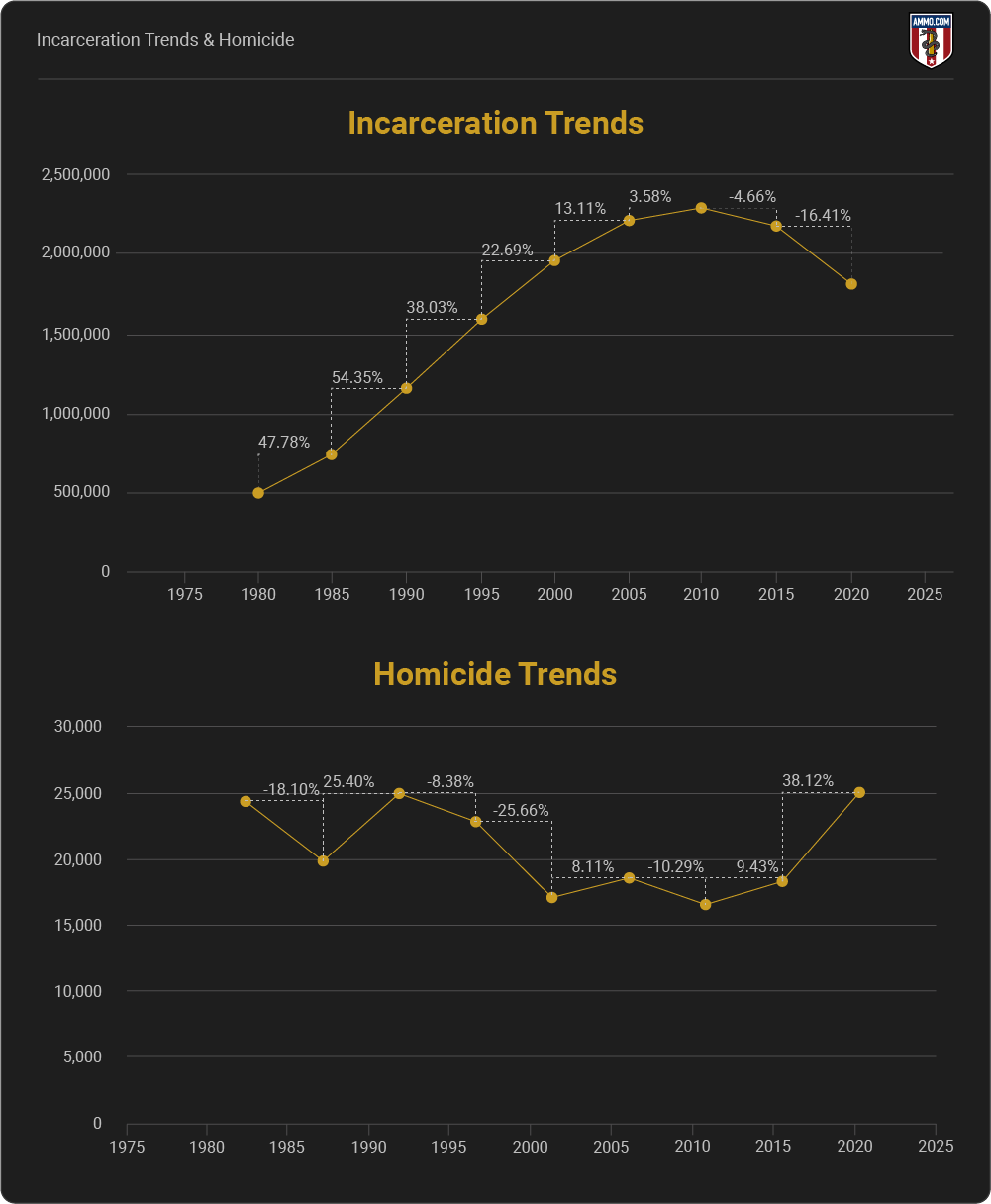Gun Control Laws and Enforcement Trends 2024
The amount of state gun laws nearly doubled between 1991 and 2016 (Source).
The first federal gun control law was passed in the 1934 National Firearms Act, which limited civilians’ access to machine guns, suppressors, short-barreled shotguns, and others (Source).
Between 1886 and 2023, the Supreme Court of the United States interpreted the Second Amendment to include the right of the individual to keep and bear arms six times.
Homicides (all methods) increased 27% from 1968 to 2021.
Homicide rates increased 28% while incarceration rates fell 15% during the 2020 pandemic.
The 1994 Crime Bill authorized $12.5 Billion dollars for law enforcement, while the ATF receives $1.5 billion annually to enforce federal firearm laws.
The ATF seized more than 360,000 firearms in 2021 (Source).
Timeline of Federal Firearm Laws in the U.S.
Laws
1934 National Firearms Act
1938 Federal Firearms Act
1968 Gun Control Act
1986 Firearm Owner’s Protection Act
1988 Undetectable Firearms Act
1990 Gun-Free School Zones Act
1993 Brady Handgun Violence Prevention Act
1994 Public Safety & Recreational Firearms Use Protection Act
2022 Protecting Our Kids Act
Supreme Court Cases Involving Individual’s Rights to Bear Arms
1857 Dred Scott v. Sandford - Determined Slaves do not have 2A rights.
1875 US v. Cruikshank - The right of the individual to keep and bear arms.
1886 Presser v. Illinois - States can ban individuals from forming militias.
1939 US v. Miller - Courts ruled the Federal Government can regulate firearms not effective for militias (i.e. short-barreled shotguns).
1980 Lewis v. United States - Upheld that felons cannot keep and bear arms.
2008 District of Columbia v. Heller - Determined that an individual does not have to be a part of the militia to keep and bear arms.
2010 McDonald v. City of Chicago - Determined that the Due Process Clause of the 14th Amendment also applies to the Second Amendment.
2016 Caetano v. Massachusetts - Determined that the 2nd Amendment applies to firearms that did not exist in 1791.
2020 New York State Rifle & Pistol Association, Inc. v. City of Bruen - Ruled that states must maintain a “Shall-Issue” stance of concealed carry outside of the home.

Economic Costs of Enforcing Gun Laws
ATF - 2022 - $1.5 Billion
NICS - 2022 - $8.4 Billion
Criminal Justice System - 2022 - $12.62 Billion
*Compared to $2.8 Billion in medical costs yearly.

ATF Conviction Stats
34,436 Cases Initiated
10,138 Recommended for prosecution
6,315 Prosecuted
5,338 Convicted
*The Federal Government prosecutes 18% of all cases initiated.

Gun Laws & Prosecution Trends

Firearm Laws & National Homicide Trends
Homicides in the U.S. are now 27% higher than before the 1968 Gun Control Act (per capita). They declined by nearly 20% after the 1994 Crime Bill and remained low until 2015. Homicide rates sharply increased in 2019.

Incarceration Trends & Homicide

Sources
- Incarceration Trends
- Firearm Homicide Trends
- BJS Incarceration Trends
- 2022 Incarceration Data
- Impact of the 1994 AWB
- BJS Firearm Homicide Trends
- 1990-Present Homicide Data
- BJS Incarceration Trends
- FBI NICS Budget
- Gun Violence Research Budget
- Federal Firearm Prosecution Trends
- BJS 2020 Incarceration Stats
- 18 U.S. Code § 922
- 18 U.S. Code § 924
- 26 U.S. Code § 5861
Infographics
- Are Guns & Ammo The New Gold? Why More Americans Are Arming Themselves
- The Greatest Gun Salesman In America: President Barack Obama
- Shooting Straight: How Both Presidential Candidates Have Changed On Gun Control
- President Obama: (Still) The Greatest Gun Salesman in America
- An Inconvenient Truth: How The Obama Administration Became Earth's Largest Arms Dealer
- Armed Drones: President Obama's Weapon of Choice
- COVID-19 Data Study: Ammunition Sales Continue to Soar in Response to Coronavirus Panic
- Data Study: 18 Months of Ammo Sales during a Pandemic, Protests, and the Biden Presidency
- Data Study: U.S. Ammo Sales Surge Following Russian Invasion of Ukraine
- Most Gun-Friendly States in 2024
- Worst States to be a Gun Owner (2024 Updated)
- Children & Firearms: Definitions and Demographics Make All the Difference
- Urban Violent Crime & Legal Gun Ownership
- Gun-Free School Zone Laws & School Shootings (2024 Updated)
- Gun Control Laws and Enforcement Trends 2024
- Gun Ownership by State (2024 Statistics)
- How Many Gun Owners are in America? (2024 Statistics)
- Concealed Carry Crime Stats 2024
- Accidental Shooting Statistics: A Review of Unintentional Firearm Deaths from 1979-2024
- America’s Stolen Guns: A Silent Contributor to Gun Crimes in the U.S. (2024)
- Gun Violence Statistics 2024: Comprehensive Look at the Data
- Gun Laws vs. Crime Rates in 2024: A Comprehensive Analysis
- Gun Death Statistics by Caliber: A Review of Calibers and Crime in 2024
- Anti-Gun Control Arguments 2024: Facts Gun Control Lobby Suppress
- Guns in the Home Statistics: The Effects of Firearms in the Home in 2024
- Gun Deaths in the US: Analyzing At-Risk Demographics in 2024
- How Many Guns in the U.S.: All About America’s Firearms in 2024
- Gun Facts in the U.S. 2024: The Reality of Firearms in America
- Defensive Gun Use Statistics: America’s Life-Saving Gun Incidents (2024)
- Correlation Between Mass Shootings and Prescription Drugs (2024 Study)
- Gun Ownership by Gender in 2024: Closing the Gender Gap
- Murders by Weapon Type: September 2024 Statistics
- Gun Violence Among Black Americans: September 2024 Statistics
- The Ultimate Hunting Caliber Chart: Best Cartridge Per Species
- How Old Do You Have to be to Buy a Gun: A State Guide 2024
- Most Popular Guns in the U.S.: The Must-Have Guns in 2024
- Stray Bullet Deaths: Accident and Injury Statistics in September 2024
- Mass Shooters by Race: Demographics of Assailants 1966-2024
- Ammunition Limits By State in 2024: How Much Ammo Can You Buy?
- Why Do Americans Own Guns in 2024?
- How Many Americans Want Stricter Gun Laws in 2024?
- How Many Households in the U.S. Have a Gun in 2024?
- What Percentage of Gun Deaths are Suicides in 2024?
- Average Age of Mass Shooters in the U.S.
- Firearm Ownership in America by Year
- US Firearms Deaths Per Year: A Collective Report 1968-2024
- Percentage of Americans Owning Guns in 2024
- Texas Gun Ownership: Total Numbers, Trends, and Most Popular Guns
- Gun Ownership Statistics Colorado 2025: Trends & Numbers
- Hunting Accident Statistics 2025 (Causes & Trends Per Year)
- Banned Guns & Ammo List: A 2025 Review by State
- 3D Printed Gun Laws By State
- How To Build a Home Shooting Range: The Ultimate Guide
- States With the Highest Murder Rates


